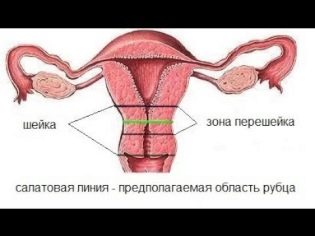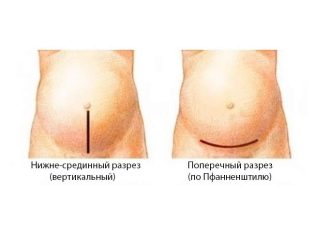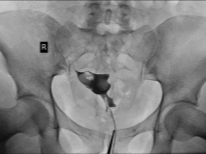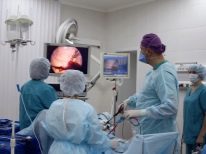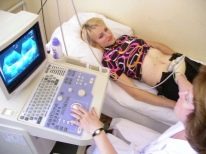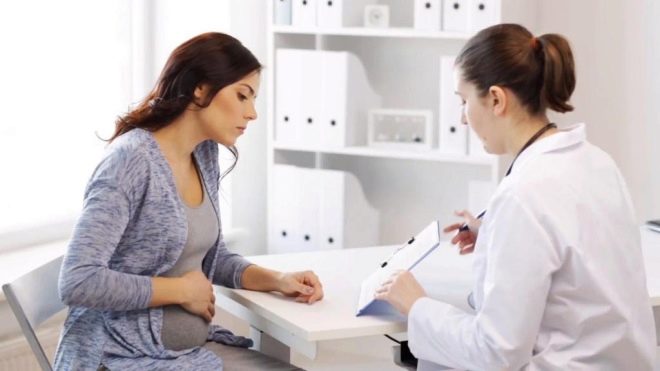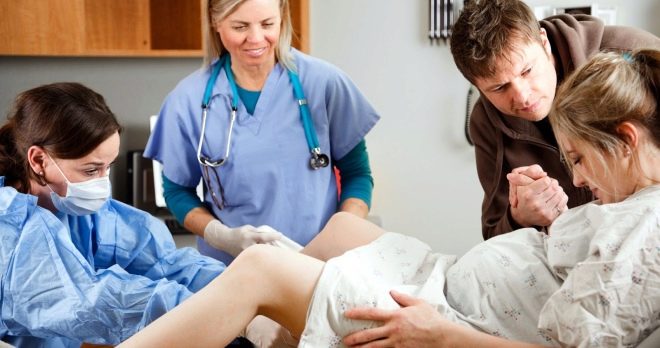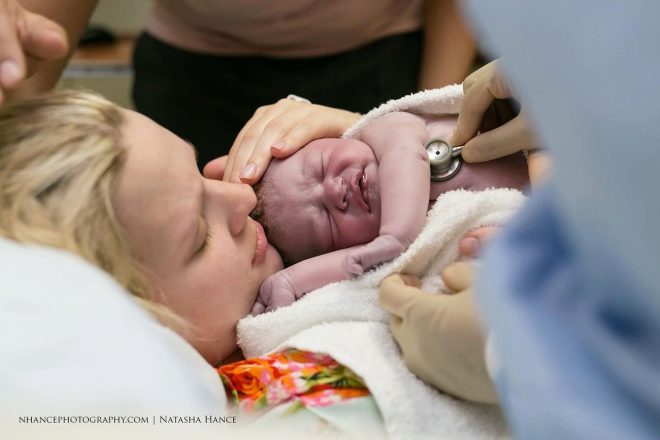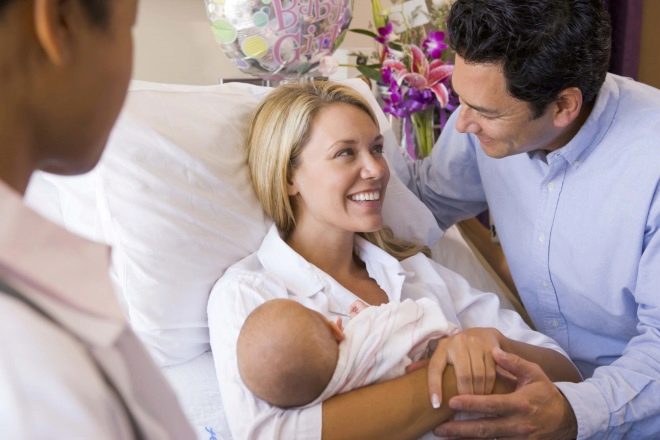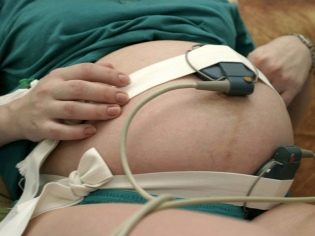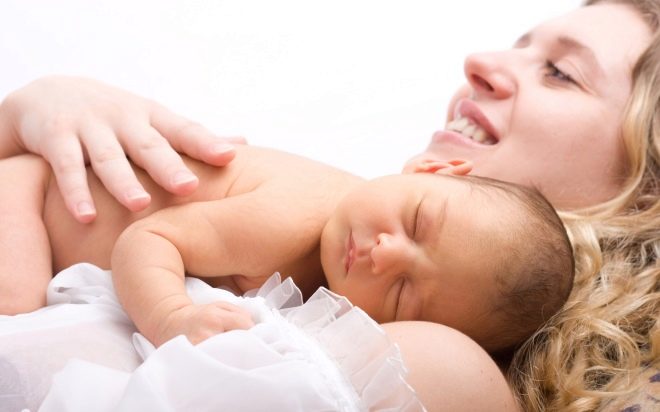Features of pregnancy after cesarean section
Many women who have undergone surgical delivery in the past are planning to become mothers again. Doctors say that there are no strict contraindications for repeated deliveries after cesarean, but we should not forget that the next pregnancy, as a rule, proceeds with additional difficulties.
How dangerous it is to give birth after cesarean section, and what should be the time interval between such pregnancies, we consider in this article.
General information
A caesarean section is a type of surgical procedure in which the fetus is removed by dissecting the anterior wall of the uterus.
The consequence of such manipulation becomes a scar on the uterine wall, the state of which is crucial in the question of the possibility of repeated delivery.
There are 2 types of incisions in the uterus, which the surgeon makes in the process of this manipulation.
- Transverse. The scar runs right at the base of the abdomen above the pubic area. On the wall of the uterus suture will be located at the bottom. From the point of view of aesthetics, the scar from such an operation is more acceptable, since after a few years it may cease to be noticeable at all. However, its main advantage is that after such an intervention, the woman will be able to give birth in the future on her own.
- Longitudinal. This is the traditional version of the operation of cesarean section, which in our time is used less and less. In this case, the scar extends slightly above the pubis line to the navel. This technique is used to save the fetus during an emergency operation. In addition, the presence of a longitudinal scar excludes the possibility of future deliveries through natural paths.
Planning time
After operative delivery it is recommended to plan conception not earlier than in 2-2.5 years. This time is enough for the body to regain its strength, and they are enough for carrying another baby, as well as for the completion of the formation of the internal scar.
All this time, women need to take care of contraception in order not to get pregnant. If conception occurs after a short time, there is a risk that the scar will not be wealthy and may threaten to rupture the uterus in the process of carrying a child or in the process of giving birth.
In order to prevent this, it is necessary to consult with the gynecologist about methods of protection from unwanted pregnancy, and the features of their use. He will advise on the most appropriate method of contraception.
Artificial termination of pregnancy during this period is highly undesirable.
Even if the moral aspects of this procedure are omitted, a traumatic impact on the mucous layer of the uterus during curettage after a short period after the operation may cause the development of the inflammatory process and the appearance of various defects of the organ wall.
However, it is also not recommended to postpone the birth of the next child for too long a period (if the woman plans to become a mother again). Indeed, over time, the scar on the uterine wall undergoes atrophic changes, as a result of which the suture loses its value, becomes coarse and inelastic.
Similar processes begin to occur on average 8 years after cesarean section, therefore obstetricians and gynecologists recommend planning conception between 2 and 7 years from surgical extraction of the fetus.
Before a specialist delivers his professional verdict regarding the possibility of another pregnancy, it is necessary to conduct a number of diagnostic studies that allow a detailed assessment of the condition of the scar. The following procedures are assigned for this purpose.
- Hysterography Depending on the method of research, x-ray and ultrasound hysterography are distinguished. This technique allows you to collect the most accurate data on the state of the uterus and the degree of patency of the fallopian tubes.
- Hysteroscopy. This is an endoscopic examination of the endometrium, the mucous layer of the uterus.
- Ultrasound.
These examinations are quite possible to undergo a year after cesarean, in order to give a qualitative assessment of the scar that has formed at the site of uterine tissue dissection.
At this point, the initial process of its formation will be completed. During the stage of diagnostic studies, the doctor is also tasked with finding out the type of organic tissue that makes up the scar. The most positive option, in terms of reproductive function, is muscle scar. A less well-to-do scar, consisting of connective tissue.
Peculiarities of labor after CS
Virtually the entire past century in the obstetric environment was dominated by the installation, according to which a woman who once became a mother through surgical delivery, all subsequent children can be born exclusively in the same way. However, modern medicine offers more opportunities.
Most obstetrician-gynecologists claim that the process of caesarean in the past is not an absolute indication for re-surgical extraction of the fetus.
Of course, if there are absolute contraindications to natural delivery, you should agree to a cesarean section and not risk your health and life of the baby for the sake of upholding its principles. However, it is not necessary, in the absence of valid reasons, to insist that your childbirth ends with a surgical extraction of the fetus.
In order for the gynecologist to approve the re-delivery, it is necessary for the expectant mother to be monitored throughout the entire period of gestation, and in time passed all the diagnostic tests assigned to her.
Important! Usually, natural births are allowed to give birth to women with a history of only one cesarean. If there is more than one scar in stock, then the gynecologist strongly recommends another surgical procedure according to current regulations.
You can give birth naturally more than 2 times, if the cause of the primary surgical extraction of the fetus are complications, which include:
- pathological prenatal position of the fetus, precluding the possibility of successful self-expulsion through the birth canal;
- late preeclampsia;
- pathologies of fetal development requiring emergency delivery;
- acute form of inflammation in the genital tract of a woman.
If the indication for surgery was organic diseases of the eye, heart, or other disorders that were not cured until the next conception occurred, then the attending physician will most likely advise the planned surgical delivery.
Natural birth after cesarean must be carried out with special care. Therefore, quite often to such women in labor on the part of the attending physician are imposed rather stringent requirements.
- The gap between previous childbirth and this pregnancy can be at least 2, but more than 8 years.
- A scar on the uterus should be located along the horizontal axis.
- "Baby seat" should be attached as high as possible, the best option for its location - on the back wall.
- Single pregnancy. If we are talking about the pregnancy of twins, then in this case the question of the possibility of natural resolution will not be raised.
- The fetal head should be the precursor to the pelvis.
- The scar must have satisfactory characteristics, confirmed by a number of diagnostic studies.
The final decision on how the delivery will take place is made no earlier than at 35 weeks of gestation. By this date, the main processes of the formation of the fetus and its mass gain will be completed. The doctor makes a positive verdict regarding the feasibility of the natural extraction of the fetus, if:
- child's body weight is not more than 3.7 kg;
- place of attachment of the placenta is at a sufficient distance from the scar;
- woman in labor is younger than 37 years;
- the woman has no signs of late toxicosis;
- scar in satisfactory condition and its thickness is not less than 2.5-3 mm.
Under all conditions, the attending physician may allow the woman to give birth independently. However, he must warn his patient that during labor she will not be able to inject drugs that stimulate uterine activity and anesthetics in order to avoid excessive uterine contraction, which can later cause her to rupture.
Possible risks
Uterine rupture is a serious complication, fortunately, in practice it occurs less frequently. Nevertheless, women are afraid of him, so no more than 18-20% of Russian women agree to an independent birth after one day cesarean.
Earlier in obstetric practice it was decided to extract the fetus by making a longitudinal incision of the uterus, that is, in the area of greatest pressure on the organ. Nowadays, such surgical manipulations are performed by transverse dissection of the uterine wall in its lower part. This technique ensures the integrity of the body of the uterus.
The probability of damage to the structure of the uterine wall in the process of natural delivery in the presence of a transverse scar varies within 0.2%. It should also be noted that the signs of the development of this pathology can be identified in the third trimester with the help of ultrasound.
Expert advice
Obstetricians and gynecologists advise a woman who wants to become a mother again after the postponed operative delivery, to take a very responsible approach to this issue. At the planning stage of conception, you need to contact an experienced specialist (for example, ask your friends, study the doctor's reviews), who can advise on the most appropriate conception terms, also conduct a detailed study of the woman's health, and give an adequate assessment of her reproductive capabilities.
Having decided to become a mother again, a woman is recommended to prepare herself properly for conception and pregnancy. To do this, you must strictly follow the following tips:
- stop smoking and drinking alcohol six months before the alleged conception;
- stop taking oral contraceptives, if used;
- before you get pregnant the second time, it is imperative that you complete a full examination for the detection of chronic inflammatory diseases of the genital tract;
- conduct supportive therapy, which includes a course taking vitamins;
- It is desirable to undergo a spa treatment.
Important! No need to cheat yourself, if the gynecologist, according to your subjective feelings, is over-reinsured. In this situation, additional examinations will not be superfluous.
It is most important to undergo ultrasound examinations in time, which will allow you to gather as much information as possible about the state of the uterus for the current period.
There is an opinion that women who are once subjected to a cesarean section should not give birth more than twice. For a woman's body, it is rather risky to subject yourself to a similar test three times. Women who decide to become mothers for the fourth time through surgical delivery are quite rare in obstetric practice. Each subsequent cesarean section increases the risk of complications. Therefore, experts strongly recommend a responsible attitude to this issue for women who already have one or more scars on the uterus.
Childbirth, even with ideal baselines, is a serious test for the future mother's health. Especially if in the past she had to face some problems during pregnancy, as a result of which the fetus had to be surgically removed. In this case, the planning of the next conception should be taken with all its responsibility.
The key to successful delivery after cesarean is the strict implementation of medical appointments and the timely passage of all diagnostic tests.
Additional information about the features of carrying a baby after cesarean section and the possibility of natural childbirth can be found in the following video.


